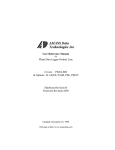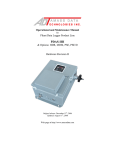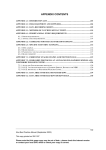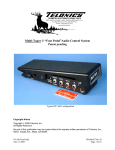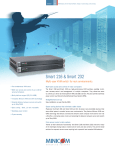Download Addendum for Version 1.02 (and later) Beta site PDAS-II
Transcript
ADDENDUM SCOPE: This addendum is applicable to all Version 1.02 (and later) Beta-site PDAS-II loggers. The features described below have been implemented in these loggers as an unofficial release. The details given below will become part of the main body of the User’s Manual with the Official Release of the PDAS-II firmware version 1.1. 1. VIEW DATA The View Data function has the added feature of displaying the current time as follows: Example: -- VIEW SENSOR DATA – T-RTC HG=0, WT=1, Select Log Slot 0 - 15 T<CR> TIME 09:11:54 (keeps updating in real-time) 2. SYNCHRONIZATION OF SAMPLING UPON POWER-UP The Beta site PDAS-II firmware has code that ensures that the sampling of sensors is synchronized with respect to the Start Time in the event of a power-down. As always, the Start Time is specified when setting up the Sensor Slot. The new firmware completes the following tasks when the logger is re-powered: 1. Disables all Sensor Slots 2. Recalculates new Start Times and Min/Max Start Times for each slot. It does this based on the Logging Rates and the original Start Times specified for each slot as demonstrated in the examples below. 3. The new Start Times are displayed in the Sensor Log Table. 4. The slots are re-enabled and the sampling and logging are resumed at the new Start Times. When the logger is re-powered without this new firmware, it does not disable the Sensor Slots but rather, it continues sampling and logging regardless of the discrepancy between the Real Time Clock and the sensor scanning timers that control the sampling and logging. The result is that although the intervals between the time-stamping of the log records will be as specified by Logging Rate and Min/Max Rate, the new records will not occur at the same time within the hour, that is, they will have been offset by a time equal to the duration of the power-down. For example, if the original Start Time was 9:24 and the Logging Rate is every 30 minutes the first log record will appear at 9:24:xx, the second at 9:54:xx, etc… However, if the unit is powered-down for 5 minutes following the second log and then re-powered, the subsequent records will appear at 10:29:xx, 10:59:xx, etc… The Version 1.02 (and later) Beta site loggers, in contrast, are fully synchronized regardless of interruptions in the power supply as shown in the examples below. ADDENDUM: Version 1.02 and later BETA site PDAS-II loggers 1 Example 1: Assume that the Sensor Log Table is set as follows: Slot No. 0 1 2 3 4 5 6 7 8 9 10 11 12 13 14 15 Log Sensor Sampling Rate Enable Command Label 0 00:00 0 00:00 1 1A1M0! /1 HG 01:00 0 00:00 0 00:00 0 00:00 0 00:00 0 00:00 0 00:00 0 00:00 0 00:00 0 00:00 0 00:00 0 00:00 0 00:00 0 00:00 Start Time hh:mm hh:mm 09:24 hh:mm hh:mm hh:mm hh:mm hh:mm hh:mm hh:mm hh:mm hh:mm hh:mm hh:mm hh:mm hh:mm Logging Min/Max MM Rate Rate Time 00:00 - A 00:00 hh:mm 00:00 - A 00:00 hh:mm 00:30 - A 03:00 23:59 00:00 - I 00:00 hh:mm 00:00 - I 00:00 hh:mm 00:00 - I 00:00 hh:mm 00:00 - I 00:00 hh:mm 00:00 - I 00:00 hh:mm 00:00 - I 00:00 hh:mm 00:00 - I 00:00 hh:mm 00:00 - I 00:00 hh:mm 00:00 - I 00:00 hh:mm 00:00 - I 00:00 hh:mm 00:00 - I 00:00 hh:mm 00:00 - I 00:00 hh:mm 00:00 - I 00:00 hh:mm Offset Scale Note that the Start Time and Min/Max Start Time are displayed in the table. By 10:30 of the first day the Log Table should look like this: AMASS Data Technologies Inc. PDAS/MDM C209 Firmware (c)William P.Thomas 1996,97,98,99 DATE: 1999/05/25 TIME: 10:30:22 UNIT ID NO: T359478 SITE DESCRIPTION: MARCEL'S DESKTOP , 1999/05/25, HG , +5.125/09:24:19 HG , +5.125/09:54:08 HG , +5.126/10:24:08 Assume the logger is powered down from, say, 10:32 to 10:38. Upon re-powering the unit the Sensor Log Table should look like this: Slot No. 0 1 2 3 14 15 Log Sensor Sampling Enable Command Label Rate 0 00:00 0 00:00 0 1A1M0! /1 HG 01:00 0 00:00 0 0 00:00 00:00 Start Time hh:mm hh:mm 10:54 hh:mm . . . Logging Min/Max MM Rate Rate Time 00:00 - A 00:00 hh:mm 00:00 - A 00:00 hh:mm 01:00 - A 03:00 11:59 00:00 - I 00:00 hh:mm hh:mm hh:mm 00:00 - I 00:00 - I 00:00 00:00 Offset Scale hh:mm hh:mm Note that slot#2 is disabled and that the Start Times have been recalculated and displayed. The new Start Times are calculated based on the Logging Rate and Min/Max Rate as well as the original Start Times of ADDENDUM: Version 1.02 and later BETA site PDAS-II loggers 2 9:24 (sampling) and 23:59 (Min/max). The slot will be re-enabled at 10:54 and the log records will be continuous as though there had been no interruption. The Log Table would appear as follows by 11:22: AMASS Data Technologies Inc. PDAS/MDM C209 Firmware (c)William P.Thomas 1996,97,98,99 DATE: 1999/05/25 TIME: 11:11:22 UNIT ID NO: T359478 SITE DESCRIPTION: MARCEL'S DESKTOP , 1999/05/25, HG , +5.125/09:24:19 HG , +5.125/09:54:08 HG , +5.126/10:24:08 HG , +5.127/10:54:08 Example 2: If the same logger had only been re-powered at 11:30 (power off at 10:32) the Sensor Log Table would look like this: Slot No. 0 1 2 3 14 15 Log Sensor Sampling Enable Command Label Rate 0 00:00 0 00:00 HG 01:00 0 1A1M0! /1 0 00:00 0 0 00:00 00:00 Start Time hh:mm hh:mm 11:54 hh:mm . . . Logging Min/Max MM Rate Rate Time 00:00 - A 00:00 hh:mm 00:00 - A 00:00 hh:mm 00:30 - A 03:00 11:59 00:00 - I 00:00 hh:mm hh:mm hh:mm 00:00 - I 00:00 - I 00:00 00:00 Offset Scale hh:mm hh:mm The new Start Time has been re-calculated and displayed. Slot #2 will be re-enabled at 11:54 and although the log will be missing two records (one at 10:54 and the other at 11:24) due to the power interruption, the subsequent entries will be fully synchronized with respect to the original Start Time as shown below: AMASS Data Technologies Inc. PDAS/MDM C209 Firmware (c)William P.Thomas 1996,97,98,99 DATE: 1999/05/25 TIME: 11:44:22 UNIT ID NO: T359478 SITE DESCRIPTION: MARCEL'S DESKTOP , 1999/05/25, HG , +5.125/09:24:19 HG , +5.125/09:54:08 HG , +5.126/10:24:08 HG , +5.128/11:54:08 . . . ADDENDUM: Version 1.02 and later BETA site PDAS-II loggers 3 3. SYNCHRONIZATION OF RTC TO GOES TRANSMITTER All GOES-equipped PDAS loggers provide automatic synchronization of their RTC to that of the GOES transmitter to which it is connected. Loggers with firmware for the Telonics TGT-1 and the Bristol B697 perform synchronization routines following each transmission as described in the manual. Loggers with firmware for the Bristol B696 perform synchronization routines at every hour. In addition to the synchronization referred to above, all Version 1.02 (and later) Beta site Firmware for PDAS-II loggers verify if a correction was required to synchronize the RTC and adjust sensor scanning timers accordingly. This adjustment of the scanning timers ensures that sampling of the sensors is fully synchronized regardless of corrections of the RTC that might take place during extreme temperature conditions. Readjustment of the sensor scanning timers (Version 1.02 (and later) Beta site Firmware only) takes place as follows: 1. As always, the PDAS-II performs a synchronization of the RTC to the clock of the GOES transmitter following a transmission (B697 or TGT-1) or at every hour (B696). 2. The PDAS-II sets a Second-Synchronization-Byte that records one of three possible conditions: a) the RTC was advanced by one second for synchronization, b) the RTC was retarded by one second for synchronization and c) no changes were made to the RTC for synchronization. 3. The PDAS-II readjusts the sensor scanning based on the condition of the SecondSynchronization-Byte as follows: a) The sensor-scanning timers are decremented by one count in order to skip a scan. By doing this, the sampling is fully synchronized to the clock of the GOES transmitter. b) The sensor-scanning timers are incremented by one count in order to add a scan. c) The sensor-scanning timers are unaffected. Without this new firmware, the sensor scanning timers are not readjusted as corrections are made to the RTC following synchronization. The effect is that the sampling of the sensors drifts when the RTC of the PDAS-II requires corrections during extreme temperature conditions. The sampling may, therefore, drift beyond a minute mark and potentially cause problems for certain data manipulation programs. 4. DIRECT COMMUNICATIONS COMMANDS A “Direct-Communications Command” has been added to accommodate the two Event Counters that are included on the PDAS-II as follows: ME# where # is either ‘1’ or ‘2’ for the desired event counter For example: ME1 +23.5 Recall that “Direct Communications Commands” are entered prior to gaining access to the menu system. ADDENDUM: Version 1.02 and later BETA site PDAS-II loggers 4 5. INDIVIDUAL SELECTION OF DATA FOR GOES TELEMETRY The Beta site PDAS-II loggers (firmware 1.02 and later) allow the user to individually enable or disable GOES telemetry of selected data. Therefore, even though several parameters may be monitored only those selected will be output via GOES. Furthermore, this selection is applied individually to the instantaneous/average data and the min/max data as explained. Note that all data, whether selected for GOES telemetry or not, is logged to the flash memory, that is, the on-board log file. For example, the B696 GOES menu appears as follows for these loggers: ---GOES Transmitter B-696--0 Initialization 1 Diagnostics 2 Enable Self-timed Transmissions 3 Display GOES log table 4 Enable/Disable GOES log functions M Main Menu ⇒ Item’3’ displays the current set-up for the telemetry of logged data. For example, 3<CR> Slot No. 0 1 2 3 4 5 6 7 8 9 10 11 12 13 14 15 Sensor Log GOES Log Data Enable Command Label 1 1A1M0! /1 HG Enabled 0 1A2M0! /1 WT Enabled 0 Enabled 0 Enabled 0 Enabled 0 Enabled 0 Enabled 0 Enabled 0 Enabled 0 Enabled 0 Enabled 0 Enabled 0 Enabled 0 Enabled 0 Enabled 0 Enabled MIN/MAX Data Enabled Enabled Enabled Enabled Enabled Enabled Enabled Enabled Enabled Enabled Enabled Enabled Enabled Enabled Enabled Enabled Note that each parameter has individual control with respect to GOES telemetry. Furthermore, this control applies to the Min/Max and the instantaneous data of each parameter. In the example above the logged data as well as the Min/Max data of both ‘HG’ and ‘WT’ will be output via GOES telemetry. ADDENDUM: Version 1.02 and later BETA site PDAS-II loggers 5 ⇒ Item ‘4’ allows the user to make changes to the GOES Log Table. For example, assume the user does not wish to output the Min/Max data of ‘HG’ via GOES: 4<CR> --- SENSOR SLOT ALLOCATION --HG=0, WT=1 Select Log Slot 0-15 0<CR> --- GOES LOG FUNCTIONS --0 Disable GOES Log Function 1 Disable GOES Min/Max Log 2 Disable Both ESC – return to GOES menu WARNING – Both log functions are now ENABLED 1<CR> à Disable telemetry of HG Min/Max data Display the GOES Log Table once more to confirm the changes: 3<CR> Slot No. 0 1 2 3 4 5 6 7 8 9 10 11 12 13 14 15 Sensor Log GOES Log Data Enable Command Label 1 1A1M0! /1 HG Enabled 0 1A2M0! /1 WT Enabled 0 Enabled 0 Enabled 0 Enabled 0 Enabled 0 Enabled 0 Enabled 0 Enabled 0 Enabled 0 Enabled 0 Enabled 0 Enabled 0 Enabled 0 Enabled 0 Enabled MIN/MAX Data Disabled Enabled Enabled Enabled Enabled Enabled Enabled Enabled Enabled Enabled Enabled Enabled Enabled Enabled Enabled Enabled ADDENDUM: Version 1.02 and later BETA site PDAS-II loggers 6 6. CONFIGURING SDI-12 PORT ‘B’ TO RS-485 The Beta site PDAS-II loggers (firmware 1.02 and later) allow the user to configure the SDI-12 Port B to either RS485 or standard HCMOS interface. If configured for RS485 Port B allows RS485-based SDI-12 communications capability for distances of up to 4000 feet. Note, however, that only sensors supporting such capability may then be connected to port ‘B’ (eg. The PSE-SDI, rev D). The configuration of SDI-12 Port B is accomplished from the SYSTEM SETUP menu. To set-up this port to RS485 proceed as follows: ---SYSTEM SETUP FUNCTIONS--0 Log File Functions 1 Sensor Setup 2 View Data Period 3 Transparent SDI Mode 4 Change PASSWORD 5 Communications 6 Sw-12V ON-Delay M Main Menu 5<CR> Select Communications Port 0 - Programmer Port 1 - Modem Port 2 - SDI-12 Ports A 3 - SDI-12 Ports B Current selection is “0 – HCMOS Dr” 3<CR> Select Physical Interface 0 0 – HCMOS Dr 1 – RS-485 1<CR> à Port B configured to RS-485 The set-up is complete! For units with the TS-SDI/DIN terminal strip the connections are made easily. Install the jumper on the terminal strip to ‘RS485’ for Port B as shown below: ADDENDUM: Version 1.02 and later BETA site PDAS-II loggers 7









